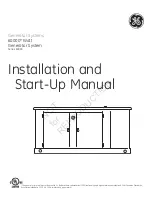
Chapter 5 Function parameter
84
Ch
ap
ter 5
5-2-10.F8 group Fault and protection
Code
Parameter name
Setting range
Factory
setting
Change
limits
F8.00
Overcurrent stall gain
0 to 100
20
☆
F8.01
Overcurrent stall
protection current
100% to 200%
150%
☆
In the process of the inverter acceleration and constant-speed-running, when the output
current reachto the overcurrent stall protection current (F8.01), the inverter lower the output
frequency; In the process of inverter decelaration, they slow down the rate of decline,then
working frequency recover until the current less than overcurrent stall protection current (F8.01)
Overcurrent stall gain is used for adjusting inhibition overcurrent capability during
ac/deceleration. The greater this value, the stronger inhibition overcurrent capability Under the
premise that the overcurrent does not occur, the best is the smaller gain setting.
For the small inertia load, the overcurrent stall gain should be small, otherwise which
cause the slower system dynamic response. For the big inertia load, the overcurrent stall gain
should be large, otherwise the poor inhibitory effect may cause overcurrent fault.When the
overcurrent stall gain is set to 0, the overcurrent stall function will be canceled.
F8.02
Motor overload protection
Prohibit
0
1
☆
Allow
1
F8.03
Motor overload protection gain
0.20 to 10.00
1.00
☆
F8.02 = 0: No motor overload protection function, there may be the risk of damage to the
motor due to overheating, it is recommended that the thermal relay is installed between the
inverter and the motor;
F8.02 = 1: The inverter will determine whether the motor is overloaded or not according to
the inverse time curve of motor overload protection. Inverse time curve of motor overload
protection: 220% x (F8.03) x rated motor current, if this lasts for 1 second, the alarm of motor
will be prompted overload fault; 150% x (F8.03) × rated motor current, if this lasts for 60
seconds, the alarm of motor overload will be prompted.
User shall correctly set the value of F8.03 according to the Actual motor overload capacity,
if the value is set to too large , which may easily lead to motor overheating and damage while
the inverter will not alarm!
F8.04
Motor overload pre-alarm coefficient
50% to 100%
80%
☆
This function is used in the front of motor overload fault protection, and sends a pre-alarm
signal to the control system by DO. The warning coefficient is used to determine the extent of
pre-alarm prior to motor overload protection. The higher the value, the smaller the extent of pre-
alarm in advance.
When the cumulative amount of inverter output current is greater than the product of the
inverse time curve of overload and F8.04, the inverter multi-function digital DO will output
"Motor Overload Pre-Alarm" ON signal.
F8.05
Overvoltage stall gain
0 (no overvoltage stall) to 100
0
☆
F8.06
Overvoltage stall protection
voltage / energy consumption
brake voltage
120% to 150%(three-phase)
130%
☆
In the process of the inverter deceleration, when the DC bus voltage exceeds the
overvoltage stall protection voltage/the energy consumption brake voltage, the inverter stops
deceleration and maintains at the current operating frequency(if F3.12 is not set to 0, the
braking signal is outputted the energy consumption brake can be implemented by an external
braking resistor.) and then continues to decelerate upon decline of the bus voltage
Overvoltage stall gain is used for adjusting inhibition overvoltage capability during
deceleration. The greater this value, the stronger inhibition overvoltage capability under the
premise that the overvoltage does not occur, the best is the smaller gain setting.
For the small inertia load, the overvoltage stall gain should be small, otherwise which
cause the slower system dynamic response. For the big inertia load, the overvoltage stall gain
















































